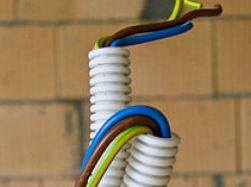Categories: Featured Articles » Electrician at home
Number of views: 57254
Comments on the article: 6
What method of laying home wiring choose
Advantages and disadvantages of open and hidden type electrical wiring
 When it becomes necessary to completely replace the electrical wiring of an apartment, the question arises of which method to lay the wire to choose. Depending on the method of laying the wire, the wiring is classified as open and hidden. Below we consider in more detail both methods of wiring, and also note their main advantages and disadvantages.
When it becomes necessary to completely replace the electrical wiring of an apartment, the question arises of which method to lay the wire to choose. Depending on the method of laying the wire, the wiring is classified as open and hidden. Below we consider in more detail both methods of wiring, and also note their main advantages and disadvantages.
Hidden electrical wiring is laid directly in the wall under a layer of plaster or under other finishing materials, for example under sheets of drywall. In addition, concealed wiring can be laid under the floor or directly in the cement screed. Sometimes the wiring is laid in specially provided channels of ceiling plates.
Open wiring is most often laid in an open way on a wall or ceiling in special plastic boxes.
The advantage of hidden wiring is obvious - it is most acceptable for the design of the apartment, as it does not spoil the aesthetic appearance of the premises. In this case, the conductors are directly in the wall, that is, they are not visible. As for the open-type wiring, in this case it loses, since it is laid along the surface of the wall and ceiling.
Open wiring, in turn, has an undeniable advantage - ease of installation and repair. For the installation of wiring in an open way, there is no need for gating the walls, further sealing the gate. It is enough to lay special plastic boxes that are easily attached to the wall or ceiling. In the future, if it is necessary to conduct an audit, repair or replacement of electrical wiring, it is enough to open the box and carry out the necessary work.
Concealed wiring will require more time and effort. First, it is necessary to prepare the strobes, lay a wire in them, and then make the seal of the strob. If it becomes necessary to repair the wiring or replace it, it will be necessary to open the strobes. In this case, hidden wiring is significantly inferior to open type wiring.
The disadvantage of concealed wiring regarding the inconvenience of its repair can be neglected, since wiring correctly calculated and installed in accordance with the requirements will last for several decades.
10 articles about various ways of laying home wiring:
Open wiring - popular wiring methods
Ways of laying wires and cables for various building structures
Wiring methods in a wooden house
Retro wiring in a wooden house
Replacement of electrical wiring in the apartment during overhaul
How to make a shtroba and fasten a cable in it
How to lay the cable from the shield to the outlet when connecting the electric stove
How to lay wires to the lamp in the absence of a false ceiling
See also at bgv.electricianexp.com
:
